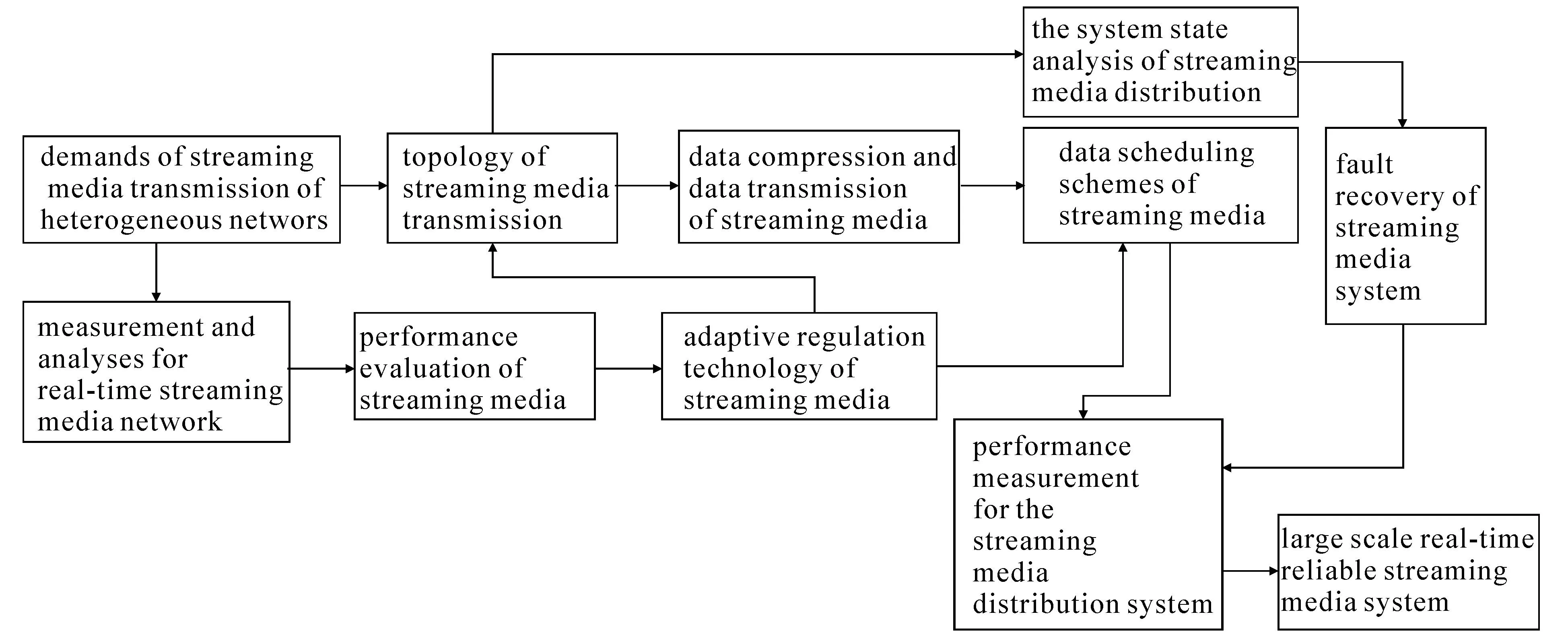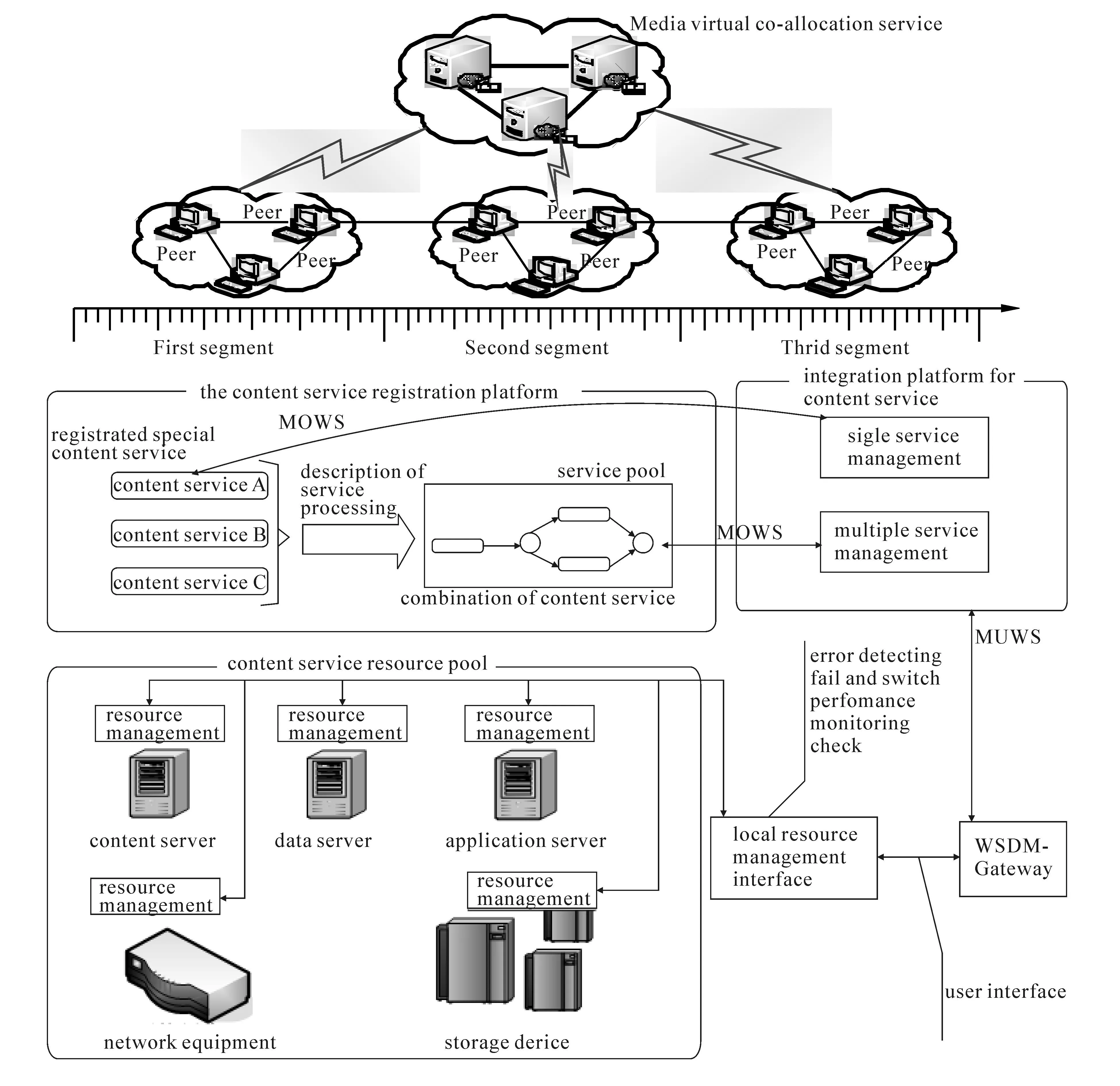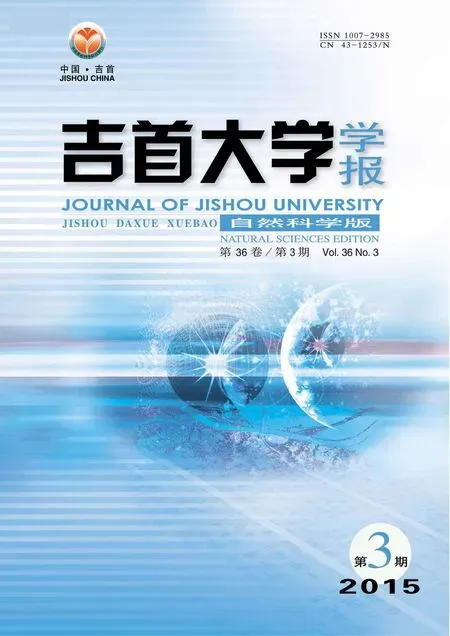Design Method for Large Scale Real ̄Time Reliable Streaming Media System
PENG Sheng,DING Lei,CHEN Binquan,YUE Guangxue
(1.School of Information Science and Engineering,Jishou University,Jishou 416000,Hunan China;
2.School of Mathematic and Computer,Jiaxin University,Jiaxin 314001,Zhejiang China)
Design Method for Large Scale Real ̄Time Reliable Streaming Media System
PENG Sheng1,DING Lei1,CHEN Binquan1,YUE Guangxue2
(1.School of Information Science and Engineering,Jishou University,Jishou 416000,Hunan China;
2.School of Mathematic and Computer,Jiaxin University,Jiaxin 314001,Zhejiang China)
Abstract:To obtain a credible and reliable streaming media system,this paper firstly analyses various possible network topologies,as well as different size data scheduling methods and their impacts,and presents an adaptive scheduling algorithm for different heterogeneous networks.Next,this paper studies real ̄time streaming quality assessment methods,and designs adaptive streaming adjustment method based on its results.In addition to this,according to the system state information and key data obtained,this paper analyses the system availability under various faults or attack conditions,then designs appropriate fault detection and system recovery method.Finally,the system implementation method to construct a large scale real ̄time reliable streaming media system is presented in this paper.
Key words:credible and reliable streaming media system;adaptive scheduling algorithm;adaptive streaming adjustment method;fault detection and system recovery method
Received date:2014-12-26
Foundation item:Supported by the National Natural Science Foundation of China (61363073,61363033,61262032);Hunan Province Natural Science Foundation of China (13JJ6058);Research Foundation of Education Bureau of Hunan Province (13A075,14C0923,13C754).Biography:PENG Sheng(1974—),male,was born in Hubei,China;received the master’s drgree from Central South University;lecturer in school of information science and Technology of Jishou University;research interests include computer networks and intelligent systems.
1Introduction
Streaming is a continuous time ̄based media,which uses streaming transmissions technologies to deliver and playback audio or video streaming in chronological order[1-3].Due to its strict chronological relationship,the features of its data flow such as continuity,real ̄time,and sequence,interactive raises high demands on the quality of service and the bandwidth usage of the network.
To accommodate heterogeneous network,Bi ̄coding technology is an alternative mainstream network coding scheme,which is similar to the variable bite rate,makeing the best compression rate selected according to the current bandwidth[4-5].However,due to the uncertainties of the VBR video system,many applications design and control problems may result in,which also brings uncertainty to the whole streaming system.
Currently,streaming media distribution architecture and protocols have become the core of the streaming media research.From this point of view,streaming media distribution protocols contains network layer protocols and application layer protocols[6-7].The network layer protocols have the advantages of high efficiency because the data routing,copying and forwarding are the responsibility of the network layer entities.However,the network layer protocols have not been widely adopted due to their high cost of deployment and lack of effective measures of transmission control and security management.Utilizing host nodes to perform data routing,copying and forwarding,the application layer protocols can effectively reduce the cost and difficulty of deployment.Of course,compared with the network layer protocols,many deficiencies in application layer protocols should to be further improved.
According to the topological organization of distributed nodes,application layer streaming media is mainly classified as tree topology and ring structure[8-10].Tree priority has better scalability,but if the dynamic network changes greatly,it will cause the multicast tree to split.Ring ̄priority protocol may be more suitable for small or medium ̄scale multicast applications because the scalability is poor due to the need of maintaining a lot of node status information.
In addition to streaming media distribution protocols,coding and network transmission,the design to schedule the streaming data are also the hotspots in recent years.To further ensure the data transmission performance and enhance system reliability,the authors also need a new dynamic streaming media distribution technology to adapt for the current network status obtained using the network measurement and assessment.
As stated above,this paper proposes an idea to establish a credible and reliable large ̄scale real ̄time online streaming media distribution system.First of all,the data scheduling strategies and algorithms in terms of the network topology established for the trusted data transmission in complex large ̄scale heterogeneous network will presented.Secondly,the authors will study the network measurement for streaming media to identify a suitable criterion for assessing the quality of data transmission,and propose an adaptive data transmission adjusting method.Next,the key data and current state of the system are obtained through studying the service delivery mechanisms for the streaming media system,and the fault detection means and system recovery steps for streaming media system are proposed through the analysis of the system availability under the condition of various failures and attacks.Finally,the system implementation method to construct a large scale real ̄time reliable streaming media system is presented.
2Module Design
2.1 Network Topology
Through analyzing the influence factors of the receiving and forwarding capabilities of the streaming distribution node,such as the nodes’ processing capacity,the effective bandwidth,and cache etc.,the authors explore the way to obtain stable,reliable and credible data transmission system in heterogeneous environments.
After analyzing the advantages and disadvantages of various content distribution networks,such as tree networks,mesh networks and ring networks,the authors identify the existing performance bottlenecks,and design an integrated transport network topology which combines the tree and ring topologies.
The system reliability is improved after introducing the enhanced ways of network topology,such as two ̄way ring,virtual ring,redundant ring,etc.Through additional layer of security module,the system’s credibility and reliability is enhanced.So the distribution network topology can be further optimized after considering the actual operating conditions.
2.2 Data Scheduling
The authors analys the short ̄range and long ̄range correlations of network video encoding,and propose effective node selection algorithm to deal with node failures and other issues,when the authors study the dynamic scheduling algorithm based on the current link status and network topology.
According to the data storage conditions and latency requirements of the media player,the authors design the common scheduling method for sending of periodic probe messages,and the special scheduling method for some urgent cases,such as the streaming media player timeout,the occurrence of the user drags play,node selection failure,etc.
The authors canforecast the network traffic trends based on network measurements.Integrating the use of sliding window and adaptive coding,the authors analys the specific effects of various fine ̄grained and coarse ̄grained scheduling algorithms in different transceiver modes.Then the authors design adaptive data scheduling strategy to adapt to a variety of heterogeneous networks,maximize the quality of service and improve the credibility of the data transmission.
2.3 Adaptive Regulation Technology
Through studying a variety of network measurement methods for streaming media,the authors explore the active measurement method based on ICMP/IP to obtain end ̄to ̄end performance indicators,including the following areas:the utilization of throughput and bandwidth in network layer,Packet loss rate,delay and delay jitter in the transport layer,media playback rate,cache time,frame rate and the number of repeated buffer in the application layer,etc..The distribution of network traffic is obtained using various monitoring methods in link ̄level,packet ̄level and business ̄level.Furthermore,the system bottlenecks is identified to help control and adjust the use of a variety of business resources,and the quality of streaming media transmissions can be guaranteed.
Through using the above end ̄to ̄end performance indicators and the current network conditions,combined with the entire network traffic analysis techniques such as OD flow matrix analysis and chromatographic analysis,the authors obtain the practical situation of the whole network traffic composition and distribution.Furthermore,the authors develop the streaming media performance measurement methods and obtain the quality assessment methods,when the authors make use of some mathematical methods such as statistical learning,Bayesian network such as NoParse,QuickParse,FullParse and MSE/PSNR.
The authors can study the adjustment method based on the performance assessment of the network topology,and adjust the structure of the transmission network using the comprehensive isolation,replace,load balancing,and redirection techniques etc.
The authors can obtain the adaptive streaming data scheduling techniques based on real ̄time measurement under the flowing conditions:different network equipment,media distribution protocol standards,especially on the distribution behavior characteristics of the application layer business,and the behavior characteristics of streaming distribution and data scheduling which are integrated with the features of search,selection,failure handling,performance characteristics fragment selection,security and other issues.
Finally,through analyzing the correctness and stability of these automatic adjustment algorithms,the authors improve automatic adjustable ability under different network conditions,and enhance the changes of survival and credibility of the system.
2.4 Data Compression Algorithm
The authors can propose a highly effective data compression algorithms to improve the compression ratio and enhance scalability,while ensuring the reconstruction quality of video.More specifically,the hierarchical coding can be improved in the following three areas:time,space and the signal to noise ratio.
The Fine coding scheme,such as Fine Granularity Scalability,Progressive Fine Granularity Scalability,Fine Granularity Scalability Scalable,Fine Granularity Scalability Temporal,etc.,can considered to be combined with traditional coarse ̄grained algorithm to form a new scalable coding scheme.Using this kind of scalable data compression algorithms,combined with data transmission algorithm,a low ̄latency,scalable,and highly reliable large ̄scale real ̄time streaming media system can be built.
2.5 Fault Detection and Recovery
The various encountered failures and network attacks found by exploring streaming media system state transition conditions and timing relationships.The impact on system brought by the various encountered failures and network attacks are estimated by analyzing the possible state changes and the incurred data loss.
Based on the state analysis,the authors can develop the system attacks detection and recovery techniques,including lightweight fault detection method,hierarchical status and core data replication,distributed storage,local fast recovery,etc.,and enhance the credibility and availability of streaming media systems.
3System Implementation Method
As is shown in fig. 1,combining some scalable compression algorithms,the authors make use of specific multicast technology,cumulative layered or non ̄cumulative layered,to build a low latency,scalable,highly reliable large ̄scale real ̄time streaming media distribution system.

Fig.1 Implementation Method
The concrete steps are described as follows:
Step1:Figure out the demands of credible streaming media transmission through analyzing the state ̄of ̄the ̄art of the credible large ̄scale streaming media technology and the characteristics of heterogeneous networks.
Step2:Point out the performance bottlenecks under the condition of streaming media transmission,through analyzing the advantages and disadvantages of the network topology,such as tree networks,mesh networks and ring networks.Design the streaming media distribution topology based on the combination of tree networks and ring networks under the condition of heterogeneous networks.
Steps3:Design the scheduling mechanism to ensure quality of service in dynamic system environment based on the designed topology.Design data scheduling methods to adapt to the current network conditions based on sliding window caching mechanism and adaptive coding technology.
Step 4:Design the measurement method for streaming media network to obtain end to end transmission performance metrics and the current flow distribution of streaming media.Develop performance assessment methods and design adaptive distribution method for a variety of different network status.
Step 5:Design the service mechanism of streaming media based on the proposed topology and scheduling strategy,and propose the fault detection and recovery methods for streaming media system.
Step 6:Design simulation experiments to analyze and evaluate the performance of the key stream media distribution algorithm,and improve it as soon as possible.
Step 7:Complete the development of credible streaming media distribution system for some specific monitoring programs,such as thereal ̄time remote video monitoring system on major hazard sources,the remote diagnostics and maintenance system of large equipment,etc.
Step 8:The research,development and operation environments are based on a P2P platform.
The system architecture and major subsystems are shown in fig.2.

Fig.2 Large Scale Real Time Reliable Streaming Media System
4Conclusions
This paper presents a new data distribution method for the large scale of real ̄time streaming media system.The innovation can be summarized as follows:
(1)A streaming data scheduling algorithm is presented in this paper based on sliding window and adaptive coding,according to the underlying network topology and link features which may be obtained by the network measurement.
(2)From the perspective of network measurement,how to evaluate the performance of a real ̄time streaming media system is discussed.
(3)A new data distribution method is proposed to reduce system overhead and fluctuations caused by adaptive mechanisms.
(4)The various encountered failures and network attacks will be found by exploring streaming media system state transition conditions and timing relationships,and the fault detection and data recovery technology are proposed to improve the reliability and fault tolerance of the streaming media distribution.
(5)Combined with a specific scalable data compression algorithm,a low ̄latency,scalable,highly reliable large ̄scale real ̄time streaming media distribution system can be effectively established using layered multicast technologies.
References:
[1] ZHANG Haipeng,YIN Baoqun,LU Xiaonong.Modeling and Analysis for Streaming Service Systems[J].International Journal of Automation and Computing,2014,11(4):449-458.
[2] OH CHAN KWONA,HWANGJUN SONG.Adaptive Tree ̄Based P2P Video Streaming Multicast System Under High Peer ̄Churn Rate[J].Journal of Visual Communication and Image Representation,2013,24(3):203-216.
[3] MUHAMMAD ABID MUGHAL,WANG Haixia,WANG Dongsheng.The Case of Using Multiple Streams in Streaming [J].International Journal of Automation and Computing,2013,10(6):587-596.
[4] WANG Hongqi,JIANG Hualong.A New Network Coding Mechanism Based P2P Streaming Media System Model[C].Xi’an:2011 IEEE 3rd International Conference on Communication Software and Networks (ICCSN),2011:380 - 383.
[5] ZENG Shuai,LI Lemin,LIAO Dan.A Distributed Flow Rate Control Algorithm for Networked Agent System with Multiple Coding Rates to Optimize Multimedia Data Transmission[J].Mathematical Problems in Engineering,2013(2013):1-11.
[6] CASTRO M,DRUSCHEL P,KERMARREC A ̄M,et al.Rowstron Scribe:A large ̄Scale and Decentralized Application ̄Level Multicast Infrastructure[J].Infrastructure IEEE Journal on Selected Areas in Communications,2002(108):100-110.
[7] RATNASAMY S,HANDLEY M,KARP R,et al.Application ̄Level Multicast Using Content ̄Addressable Networks[C].London:Proceedings of 3rd International Workshop on Networked Group Communication,2001:14-29.
[8] JINSUL KIM.Topology and Architecture Design for Peer to Peer Video Live Streaming System on Mobile Broadcasting Social Media[C].Seoul:International Conference on Information Science and Applications (ICISA),2014:1-4.
[9] HUANG CHUNGMING,CHIA ̄CHING YANG,CHENG CHUNGHENG.Layered P2P Video Streaming Using Asymmetric P2P Topology and Membership Management[J].Journal of the Chinese Institute of Engineers,2014,37(6):731-740.
[10] WAYSIALTUHAFI AMMAR.A Review on Peer ̄to ̄Peer Live Video Streaming Topology[J].International Journal of Computer Applications,2013,68(5):6-14.
DOI:CLC number:TN919.85Document code:A10.3969/j.issn.1007-2985.2015.03.005
Article ID:1007-2985(2015)03-0019-06

